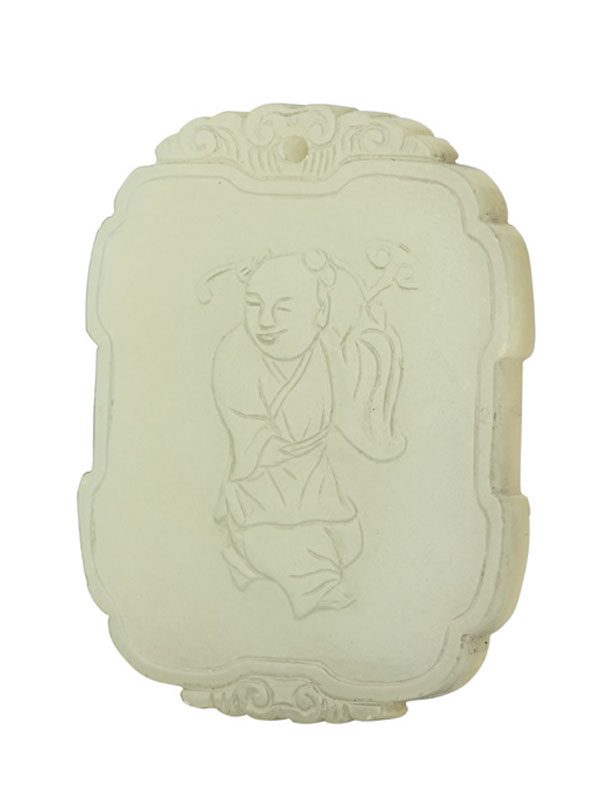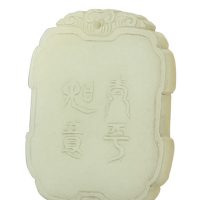Jade plaque with boy holding a spray of lingzhi
China, 18th century
A jade plaque of oval outline, the raised border tucked in at the sides. The front is carved with a boy dressed in a short, long-sleeved robe over trousers, holding a spray of ruyi-shaped lingzhi fungus over his shoulder. The top and the base of the plaque are carved with ruyi symbols. The top is pierced with a hole for suspension. The back of the plaque is carved with an inscription in four archaic characters reading Tai Ping, Ru Yi, meaning “peace” and “all your wishes”. The stone is of a very pale celadon, almost white tone.
The Chinese term ruyi is a compound of ru “like” and yi “wish” so can be translated as “all your wishes”. It is a very popular motif in Chinese art. Therese Bartholomew states that a “.. boy carrying a wish-granting wand (ruyi) represents the phrase jiaxing ruyi, meaning “May everything be auspicious and may all your wishes come true”.[1] A very similar plaque with ruyi form clouds on top is in the Hotung collection. Describing this plaque Rawson says that “As James Watt has pointed out, the use of images as illustrations for auspicious sayings was a development of the Ming, and they were particularly common on plaques such as this one.”.
Provenance:
Major Henry Ferdinand Stanley MC (1911 – 1997)
Major Stanley was appointed the first director of the Hong Kong Tourist association in 1957.
1 Tse Bartholomew, T., Hidden Meanings in Chinese Art, Asian Art Museum, San Francisco, 2006, 8.12.1, p. 237
2 Rawson, J. Chinese Jade from the Neolithic to the Qing, The British Museum Press, London 1995, no. 25:34, p. 346 & 7
清中期/白玉童子持灵芝玉牌
此牌玉质莹润洁白,包浆厚重均匀。其整体呈长方形,额首与底部雕刻皆雕刻如意纹相呼应,两者间留大面积开光,外起凸线为边框,框内减地一层,地子平整。其一面雕持灵芝童子,身形矮胖,面庞圆润,微带笑意: 一面雕四字篆书 “太平如意”,在主题上与另一面的灵芝相呼应,可见工匠巧思。
来源:英国Henry Ferdinand Stanley少校旧藏 *Stanley少校曾于港英时期担任香港旅游协会(现香港特区旅游发展局)会长


